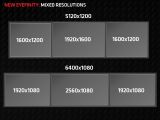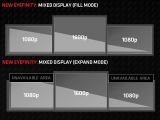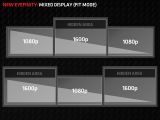Using more than one monitor for a single video stream from a personal computer has been possible for a long time, but the technologies that enable this capability evolve like every other, and that's what has just happened to Eyefinity.
Eyefinity is the brand name that Advanced Micro Devices chose for its method of spreading an image over three different displays.
AMD actually beat NVIDIA to this by years. And when NVIDIA did catch up, it needed an SLI multi-card setup to make 3D Vision surround happen.
Meanwhile, AMD has not only perfected the triple-display Eyefinity technology, which works on single boards by the way, but also Eyefinity 6.
Eyefinity 6 can spread an image (like a film or game) over six monitors, and it, too, works on single graphics cards, but just CrossFireX setups (CrossFire is the multi-card technology from AMD).
However, there has always been one limitation, of sorts, to Eyefinity: it needed more or less identical displays.
Well, it was convenient if you bought six of the same panel, especially if the bezel was thin, but the main issue was having the same resolution (and refresh rate for that matter, though it wasn't quite as essential).
Now, it's been discovered, thanks to the folks at VideoCardz, that Eyefinity 3, the latest version of the tech, will not have this limitation.
You'll be able to set different resolutions for monitors, meaning you'll have more options when it comes to buying them, or using some old displays you have lying around.
There are three new modes as a result of the different resolution support. The first one, “Fit Mode,” keeps vertical pixel counts constant among displays.
The second mode, “Expand Mode,” takes the vertical display count of the primary, larger central panel and imposes it on the flanking displays. It creates unavailable areas, but prevents the image from being skewed or otherwise warped.
Finally, the “Fill Mode” will fill out the native resolutions of the displays and leave none of the “unavailable areas.” The resulting image might not be quadrilateral, depending on the resolutions of each display.
We actually doubt that the multi-resolution support will matter much, since most monitors and TVs use Full HD anyway (1920 x 1080 pixels), but if you want a central 4K TV and wish to use two Full HD monitors on portrait mode to flank it, then the new feature will make it happen. Eyefinity 3.0 will be part of the Catalyst 14.6, due for June 2014.

 14 DAY TRIAL //
14 DAY TRIAL // 


